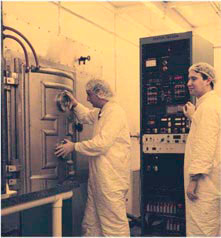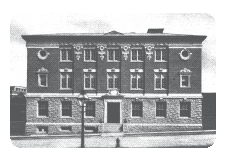
© "Max Levy Autograph, a manufacturer of high-precision phototooling and delineated parts in optical, thin film, metallic, ceramic, and other substrates."
Max Levy Autograph Company, 1902
240 Roberts Avenue, Philadelphia PA 19144
© Harold E. Spaulding,
Workshop of the
World (Oliver Evans Press, 1990).
The structure at 240 Roberts
Avenue was built in 1902, when Max Levy moved there from
Arch Street in Philadelphia. About 1875, Max and his
brother Louis had developed a method of producing a
permanently etched glass screen for use in half tone
printing. The process used a ruling engine to cut lines
on a sheet of glass coated with varnish; the glass was
then exposed to hydrofluoric acid, which etched it to a
depth sufficient to receive an opaque pigment and wide
enough to equal the unetched space in between. Two such
plates held together by Canadian balsam made a pattern of
apertures equal to 25% of the original area. The artwork
to be reproduced was then photographed by a "gallery"
camera, so called because in the days before high
quality, artificial lighting, photographs were generally
taken in a naturally lit gallery. Levy's screen was
placed before the film plane of the camera, and the half
tone negative film, composed of an image of dots, could
then be used to contact print a printing plate. The
positioning of the camera permitted the scaling of the
artwork to any ratio. The cameras were built by Joseph
Levy, Max and Louis's brother, who lived in London. Max
and Louis Levy patented their process in 1893; Louis
assigned his rights to Max. 1

© Max Levy
Autograph.
Max Levy chose the site at 240 Roberts Avenue because it
provided a huge granite outcropping for seismic
stability. On it, he erected a reinforced concrete
building, one of the first in the nation. The building
has a brick and stone exterior. 2
Max sold the firm
to his nephews Lionel and Howard in 1920. They ran the
firm until 1965, when Edgar B. Coale took over the
operation. During his tenure, Coale contracted the
construction of a computer-controlled X-Y plotter, which
operates on interferometric principles. Polichrome, an
Italian contact screen maker, bought the firm in 1978.
1 Louis Levy held two
other patents, one for a photoelectrotype process in
1875, the other for an acid blast machine in 1899.
The acid blast permitted fast, very uniform
etching, important to the screen's quality.
2 Max received his degree
in architecture from the University of Pennsylvania.
Update May
2007 (by
Linny Schenk & Michael Parrington):
As of 2005 Max Levy Autograph
was scheduled to move to a new building in Byberry East
Industrial Park in two years. The new building is a
Northeast Philadelphia industrial expansion/relocation
project being funded by a Pennsylvania Industrial
Development Authority loan (NE Times Nov. 10,
2005).
See
also:
Max Levy Autograph - corporate
website.